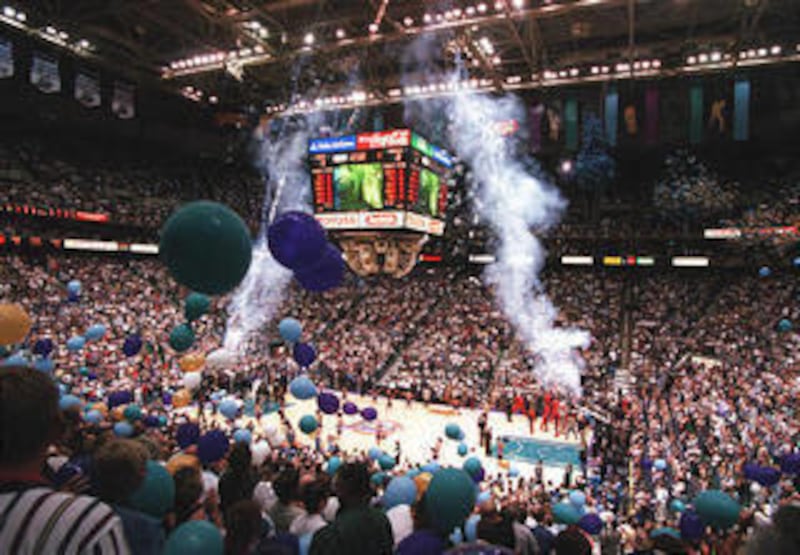A company goes up for sale whose financial records indicate a loss of $17 million over 11 years. You can buy one half of this company for $8 million, over twice your net worth. Crazy? Maybe. But to keep the Jazz in Utah, it was exactly what the doctor ordered.
Utah had proven itself a viable basketball market by supporting the American Basketball Association's Utah Stars from 1970-76. In 1979, the New Orleans Jazz relocated to Salt Lake City hoping to see positive cash flows. The Salt Palace sold out only six times in the first four seasons of hosting the Jazz. Though support grew at a steady pace afterwards, by 1985 the most profitable year in Jazz existence was a net loss of $1 million.
The Utah Jazz did nearly everything to stay afloat in Utah. In 1982, the Jazz sold their No. 3 draft pick, Dominique Wilkins, for $1 million. In 1983-84, the Utah Jazz moved 13 home games to Las Vegas to generate more revenue. In 1984, efforts were made to sell the team in its entirety. When asked by a fan what time the Jazz game started, Frank Laden jokingly replied, “What time can you be there?”
In 1985, unsuspecting Larry H. Miller received a letter asking for an investment to help the Jazz stay in Utah. The Jazz hoped to find 10 investors willing to bite. Miller was not interested in being one of ten 5 percent owners, though. But he discovered through further discussion that half of the team was up for sale for a hefty $8 million. Miller stepped up to the plate and agreed to raise the money. In his words, “I knew we had to keep [the Jazz] in Utah somehow. This was important to me.”
After committing to raise the money, Miller faced a board of directors’ deadline. Miller had nine days to raise the capital; otherwise, the franchise would be sold and moved to Miami. Daily calls, visits, meetings and conversations combined with little sleep amounted to $7 million of the $8 million required. Miller called an emergency meeting with all four investing companies in hopes of raising the last million. Seven minutes before the deadline, Miller got a nod of approval and rushed to the Salt Palace to announce his $8 million commitment. The announcement was made just two minutes before the deadline.
The next season, half-owner Sam Battistone was in the process of selling his half of the Jazz to a partner who wanted to relocate the team to Minnesota. Though Miller could have sold his half of the Jazz and made a profit of $1.5 million, he instead bought the other half and added $14 million of debt. Miller was asked, “Doesn’t it make you nervous having to pay [$333,000] of interest each month?” Miller replied, “No, I just think of it as $10,000 a day.”
The 1988 season brought Miller his final and largest hurdle to maintain ownership of the Utah Jazz: a new collective bargaining agreement to raise the salary-cap by over $1 million every year. Breaking even under the new CBA would require a sell-out every night with a nearly tripled ticket cost. Miller quickly decided it was time to build a new arena.
Financing the new arena was beyond tricky. Nearly a year of presentations to many investors and Salt Lake County left Miller frustrated at best. No lender in the U.S. would even consider financing the entire loan. Finally, Miller came into contact with a Japanese bank that approved a $66 million loan. This, coupled with a $20 million municipal bond, financed the new arena. The arena had to be done quickly to beat the ever-growing salary cap. To hasten the construction, utilizing a technique called fast-tracking was essential. Fast-tracking is building and planning simultaneously, staying one step ahead of the construction and assembling off-site where possible. The Delta Center (now EnergySolutions Arena) reached completion after 15 months and 24 days.
Miller took on an incredible amount of risk to keep the Jazz in Utah. Without question, his efforts are the biggest reason the Jazz are currently here and not in Miami or Minnesota. After taking on a business with 11 years and a -$17 million track record, the Jazz are cemented in Utah and could arguably sell for $1 billion today.
Much of the information in this article was provided by Larry H. Miller's autobiography "Driven: An Autobiography" by Larry H. Miller with Doug Robinson, published in 2012.
Dustin Jensen is a Utah native. He is studying accounting at the University of Utah, enjoys running and is a Utah Jazz fanatic. You can e-mail him at big_jazz_fan@hotmail.com.



